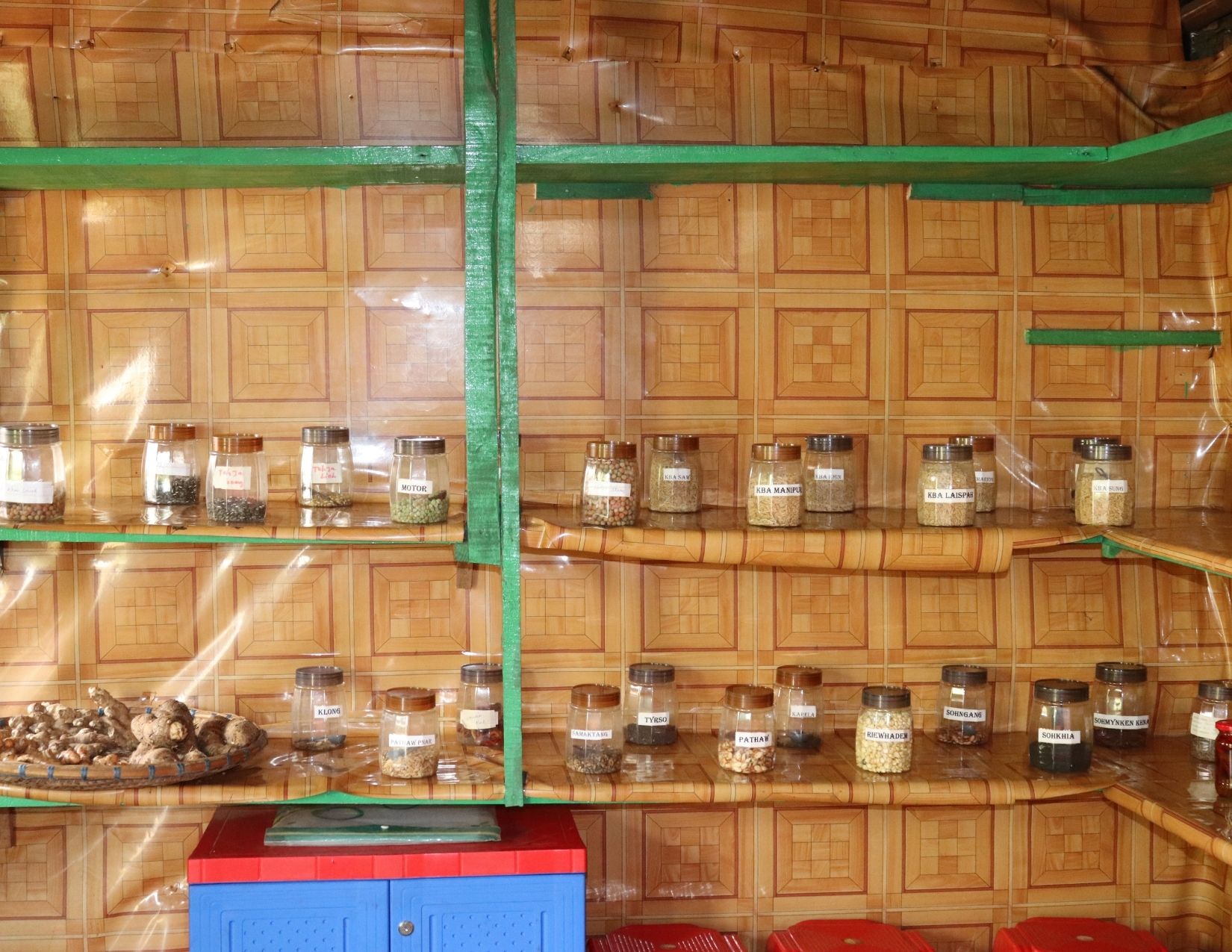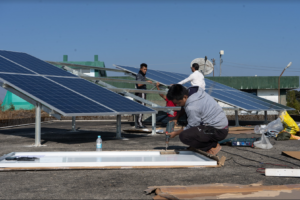By Gratia E Dkhar and Bhogtoram Mawroh
During the height of the pandemic, in 2020, members of the Madanrtiang Agroecology Learning Circle (ALC) looked up to two of their elderly members, Shildamon Lamare and Wing Lamare to help them document and preserve the local varieties in their community. “Most young farmers”, they said, “are losing the knowledge of the crop diversity in their community” and the need for a collective effort to safeguard the traditional seeds was felt. Madanrtiang became one of the 10 communities across Meghalaya and Nagaland to take part in the initiative to conserve and promote traditional seeds under the Rural Electrification Corporation (REC) supported project “No One Shall be Left Behind Initiative: Biodiversity for Food, Nutrition and Energy Security, Meghalaya and Nagaland”. This initiative is the Community Seed Bank which according to Pitambar Shrestha, Ronnie Vernooy and Pashupati Chaudhary in their 2012 book “Community Seed Banks in Nepal” is an example of local level institutions created to address issues of seed conservation, particularly of farmer varieties which includes see selection, production, improvement and marketing.
Indigenous people across the world have long preserved seeds and have in depth traditional knowledge about the locally adapted varieties. In many of such communities women have played a prominent role in the saving and collecting of the seeds of traditional crops. Such seeds are stored by individual households and there are wide variations in the diversity and quantity of seeds and planting materials saved by the family. The choice of seeds to save is influenced by preference for consumption, market, suitability to climate and cultural factors. This is supported by seed sharing and seed exchanges, an important practise in these informal seed system that ensures the seed diversity in a community. The diversity documented by NESFAS during its participatory mapping revealed that there is an average of 200 food plants found in a single village. Most of these are from the traditional varieties which have been saved by the community for many generations. The Community Seed Banks are meant to be storehouse of such traditional varieties, especially of the ones that are under severe threat.

In recent years, the local seed systems in most of the local communities have come under threat from economic, environmental and socio-political factors that have resulted in narrowing down of the genetic diversity in the community. This has put to risk the food and seed sovereignty essential for maintaining resilient local agroecoystems. Furthermore, Unfavourable policy initiatives can exacerbate the problems, while favourable ones can strengthen it. The Draft Seeds Bill, 2019 falls in the former category.
Matters of seeds in India are governed by several legislative and policy frameworks such as Seed Act (1966), Seed Rules (1968), Seed (Control) Order (1983), New Policy on Seed Development (1988), Plants, Fruits and Seeds (Regulation of Import into India) Order (1989), Protection of Plant Varieties and Farmers’ Right Act (2001) and the Essential Commodities Act (now amended) (1955) including Seeds (1955), National Seed Policy (2002) and Seed Bill (2004). The last one was meant to replace the Seed Act (1966) while the 2019 draft attempted to overcome the drawbacks of the 2004 Bill. However, there have been resistance from many quarters who feel that the latest Bill is meant to benefit the MNCs (Multi National Corporations) rather than the local farmers. A look at some of the provisions seems to justify that fear.
In the new Bill the definition of a “farmer” has been changed from one “who cultivates crops either by cultivating the land himself (or herself) or through any other person but does not include any individual, company, trader or dealer who engages in the procurement and sale of seeds on a commercial basis” to now denote “any person who owns cultivable land or any other category of farmers who are doing agricultural work as may be notified by the Central/State Governments.” What the change in definition has done is brought the corporations under the definition of a “farmer” creating an asymmetry of power relations which will lead to the marginalisation of especially small and marginal farmers who constitute more than 2/3rd of the farmers in India and Meghalaya.
Some other indications that the Draft Bill is looking to bring the corporate sector especially MNC into farming is in the section titled: Powers of Committee to specify minimum limits of germination, purity, seed health, etc. The term transgenic seeds, i.e., GM (Genetically Modified) seeds have been inserted which was not there in the past. Some may argue that this is because of the technological changes that have taken place in seeds development and therefore it was important to include new terms. But the fact that this is the domain of the MNCs and over half of the world’s seed market is controlled by only four companies viz., Mosanto (US), DuPont (US), Syngenta (Switzerland) and Group Limagrain (France) makes one wonder if that is the only cause. In India the figure is more than 60%. Such monopolistic tendencies are not very reassuring for small and marginal farmers.
What is important to remember is that the debate over GM crops is still quite contested in the country. Of the GM crops awaiting permission for large scale field trials and seed production in India, brinjal is the first one to get the approval of the Genetic Engineering Appraisal Committee. The other one is Bt Cotton. Environmentalists argue that the long-lasting effect of GM crops is yet to be completely understood and they can bring great harm to humans and the environment in the long run. By including GM seeds under the Draft Bill an indication has been given as to who the State thinks is the winner in this debate. Most worryingly, the fact that the companies are all based in the First World has the potential to create a neo-colonial circuit of appropriation of the resources of the third country like India and dismantle its Seed Sovereignty in the process.
On its parts, in an effort to address the alarming situation of loss of Seed Sovereignty, NESFAS has used the Community Seed Fairs as an approach to facilitate the exchange of knowledge and to enable the access to and use of diverse and farmer managed local seeds to promote local seed security. The Community Seed Fairs are managed and organised by farmers, supported by NESFAS. The PGS farmers of Nongtraw, Umsawwar and Agroecology Learning Circle (ALC) farmers of Pahamshiken hosted community seeds fairs on December 2020, January 2021 and February 2021 which was attended by communities from Sohra, Mawkynrew and Umling clusters respectively. In these seed fairs, more than 50 types of seed varieties were displayed and communities who maintained the highest diversities were acknowledged. These seed fairs has made possible to evaluate the level of diversity within the area and provide opportunity to exchange experiences on crops grown, level of seed production capacities, exchange and sharing of planting material and creation of market linkages. Many communities have managed to recover varieties of crops such as millet, heirloom tomatoes, rice bean etc through these informal seed exchanges. Bibiana Ranee, a custodian farmer from Nongtraw notes that “seed fairs have provided a space for us to interact with fellow farmers and discuss on strengthen our food system.” Such fairs showcase the capabilities of farmers to build social interaction and strengthen their seed system.
The Community Seed Fairs efforts have been well received by government officials who are increasingly recognising the role of farmers in securing diverse crops that would be critical to addressing the risk of food insecurity due to climate change and conflict. Mr. Gavin M. Mylliemngap, the MLA Sohra Constituency applauded the communities and NESFAS for “enhancing the farming systems by going back to the traditional methods” and reduce the environmental impact of Green Revolution.
Community Seed Banks and Community Seed Fairs are measures that NESFAS is taking in order to counter the threats to the traditional seeds which are under severe threat from many quarters. Some of the proposed policies like the Draft Seed Bill 2019 have the potential to worsen the situation. What the initiatives hope to accomplish is to combat the aforementioned threats and help indigenous farmers in Meghalaya to protect and sustain their Seed Sovereignty. This is not just an important struggle for the farmers of Meghalaya but the country as a whole.
About the writers
Gratia E Dkhar is a Lead Associate, Agroecology at NESFAS and can be reached at gratia.nesfas@gmail.com
Bhogtoram Mawroh is a Senior Associate, Research and Knowledge Management at NESFAS and can be reached at bhogtoram.nesfas@gmail.com
This article was also published in The Shillong Times



